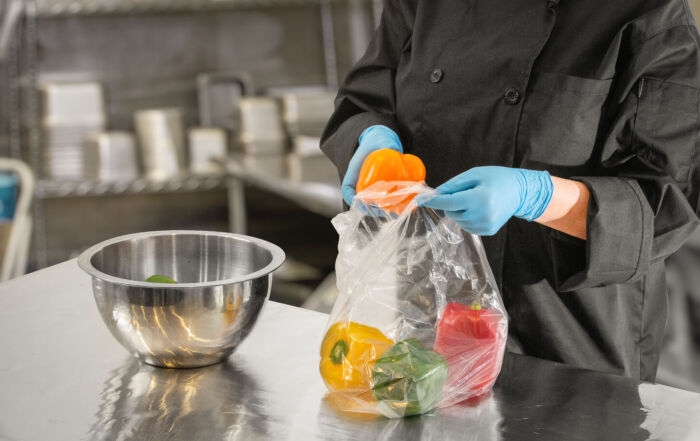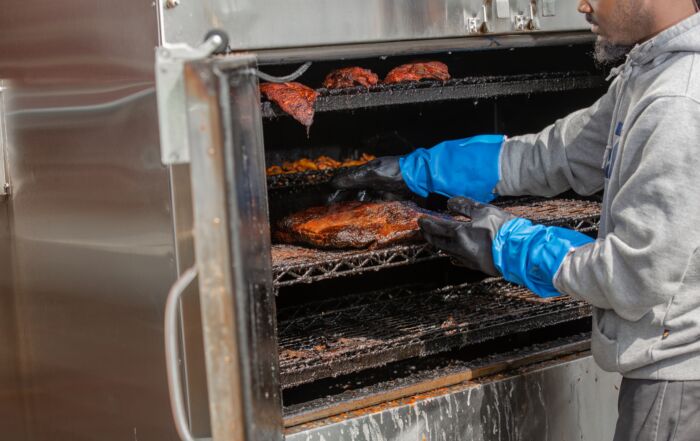Fetching a Pail of Good, Safe Water
 In the ambitious fight for food safety, don’t overlook the safety and quality of the crystal clear liquid coming out of your faucet. The United States has controls in place to ensure we have potable (safe) water that is treated and filtered to make it taste better and have no odor. Water standards and treatment are also important in food service so we don’t need a repairman twice a year to chip away the block of lime on the dishwashers heating element with a hammer and chisel in order to replace it.
In the ambitious fight for food safety, don’t overlook the safety and quality of the crystal clear liquid coming out of your faucet. The United States has controls in place to ensure we have potable (safe) water that is treated and filtered to make it taste better and have no odor. Water standards and treatment are also important in food service so we don’t need a repairman twice a year to chip away the block of lime on the dishwashers heating element with a hammer and chisel in order to replace it.
The Safe Drinking Water Act — Congress passed the Safe Drinking Water Act (SDWA) in 1974 to protect public health by regulating the nation’s public drinking water supply and protecting sources of drinking water. SDWA is administered by the U.S. Environmental Protection Agency (EPA) and its state partners.
Municipal or Community Water Systems are required to maintain high level of water quality, but we have the occasional outbreak from city water via waterborne parasites known as cryptosporidia and giardia lamblia. We’ve also had some bacterial outbreaks associated with public water treatment systems. Sounds awful. The answer to water contamination lies in effective water filtration. It can be achieved by the addition of chemicals (such as chlorination or ozone) preceded by or in addition to, carbon filters that remove larger particulates before treatment. Those carbon-based pre-filters are of varying qualities, but are essential and enhance the performance of whatever type of water filtration is chosen.
NSF International, a well known public health worldwide certifying organization for water and food contact equipment, has written several widely used standards associated with water filtration. If you purchase systems that are NSF certified and have the NSF mark on them, this helps ensure the water filtration products live up to their claims. Important documents for drinking water equipment and filtration are Standard 53 for contaminate removal and Standard 42 relates to the aesthetic quality in terms of taste and odor. NSF/ANSI Standard 61 Drinking Water System Components – Health Effects is the standard that establishes minimum health effects requirements for the chemical contaminants and impurities that may be indirectly imparted to drinking water. The standard provides the criteria used to evaluate the public health safety of materials, components, products, or systems that contact drinking water, drinking water chemicals, or both. Website: www.nsf.org
Good Water for Food Production & Service –We all know safe water is essential to human survival and in food service, it’s the foundation of everything we make in the kitchen. Our perfectly made stocks used for soups, sauces, and a multitude of stews and braised dishes start with water. Soda pop companies insist on filtered water if using a post mix soda system (dispensers mixing water, carbon dioxide, and syrup flavor onsite). Bread and bagel aficionados believe you cannot make the same product in different regions of the world simply because of the water. Even breweries are built in certain locations because of the water.
With a little research and a well qualified plumber, you will find that a variety of water filtration systems are available that are perfectly suited with the needs of ice makers, coffee machines, steam tables, mechanical dishwashers, and good drinking water.
Minerals in Water –In addition to the taste and safety standards, the natural minerals that are present in water can affect the operation of foodservice equipment. Not to oversimplify the matter, but basically it all comes down to what percentage of mineral solids are contained in the water and how alkaline or acid the water is, which is expressed in terms of pH (in science terms, the acronym means the potential or power of hydrogen). PH is the measure of alkalinity and acidity. Water that has a pH of 7.0 is neutral, below 7.0 is considered acidic and above 7.0 is alkaline.
Acidity & Water Softeners –If the water is pH is below 7.0, it’s acidic, corrosive, and able to damage steam and ice equipment. That acid condition is further compounded by the chlorine that is added to drinking water to make it safe for human consumption. Another enemy of steam and ice-making equipment is chlorides, accompanied by salt. Chlorides with salt are used to cleanse the water in water softeners, and eat away the inside steam equipment and evaporators in ice machines, so it’s essential that water softeners are installed and maintained in conjunction with proper filtration devices by a well qualified company.
Alkaline–If water is above 7.0 pH, it is alkaline (base) and is scale forming. The rock hard white scale that we can see build up on metal and glass equipment is lime. Scale buildup forms a layer of insulation on heating elements, decreasing efficiency by 40 percent.
Water hardness is a measurement of Total Dissolved Solids, or TDS. As we heat the water to boil it or put it under pressure, it loses its ability to keep solids dissolved and begins to build up as what we laymen know as “lime scale” or calcium carbonate. Water softening is not water filtration and does not remove all the impurities that make up TDS. Water heated to the boiling point will build scale nine times faster. Water under pressure, like a spray nozzle, will build scale four times faster than cold tap water.
Bottom Line: All this doesn’t exactly make us hungry, but in the food industry we have to try to lessen the risks from farm to table. At the food service level, food safety basics apply: cook foods properly, separate foods so you don’t cross-contaminate, clean and sanitize, refrigerate and rapidly chill foods properly, wash hands frequently, no bare hand contact with ready-to-eat foods, and please don’t work in food service when you are ill. In the end, it is up to the consumer to demand a safe food supply; up to industry to produce it; up to researchers to develop better ways of doing so; and up to government to see that it happens, to make sure it works and to identify problems still in need of solutions. That’s a tough challenge. No magic bullet is available for water treatment because water composition is different everywhere. But persevere. Municipal water supplies in the U.S. do their best to provide safe drinking water at the turn of a tap, which is not so easy in many parts of the world.. The right water filtration system for your operation will more than pay for itself down the line. Get an experts advice to keep the water safety and quality at its peak in your facility.
***
About the Author: Lacie Thrall

This information is provided as a general guideline and is not intended to be, nor does it, constitute legal or regulatory advice. Additional Federal regulations may apply to your particular circumstances. State, regional and local laws, ordinances and regulations may also apply.
READ MORE POSTS
Safe Handling of Leftovers in Foodservice Operations
In any foodservice operation, leftovers are inevitable. After managing a family-style restaurant, where all-you-can eat [...]
Turn your Health Inspector into your Food Safety Ally
For many foodservice operators, keeping up with evolving regulations can feel like chasing a moving [...]
Time and Temperature: Why 41°F to 135°F?
In one of my last blogs, I mentioned the temperature danger zone, or TDZ, as [...]
Maintaining Food Safety Standards Amid Seasonal Turnover
Across the country, summer seems to bring on more than just an influx of business [...]










